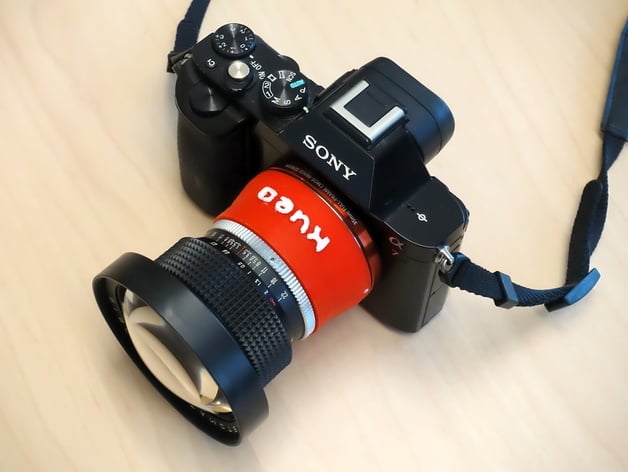
Kiev 10/15 Lens To Sony A7II-series Body Adapter
thingiverse
The Kiev 10 was the first Soviet-built 35mm SLR with automatic exposure. It did this using an internal linkage for the body to control the lens aperture -- there is no aperture control ring on the lens. The same lens mount was used by the Kiev 15 TEE, but nothing else, and the internal aperture linkage makes adapting to another mount problematic. In http://www.instructables.com/id/Using-Kiev-10Kiev-15-Lenses-On-Digital-Cameras/ , I showed a way to hack an adapter to provide a mount with an aperture control ring for Kiev 10/15 lenses, but it was awkward. Instead, the adapter shown here allows Kiev 10/15 lenses to mount and focus to infinity on a Sony E-mount body while still providing aperture control using a less-than-20-degree twist of the lens in its mount -- much like my earlier Thing 137540. Sony has two "flavors" of E-mount, the second of which is tighter, making adapters designed for the first not necessarily fit; this E-mount flange is designed to fit the later version, as used by the A7II series cameras, and also fits the earlier version (with minor play). Print Settings Printer Brand: MakerGear Printer: M2 Rafts: No Supports: No Resolution: 0.25mm Infill: 20-25% Notes: This adapter prints without supports in the orientation with the E-mount at the top and Kiev 10/15 mount on the bed. The one shown was sliced using Cura, adding a brim to ensure the Kiev 10/15 flange would stay flat and using two layers of skin with 20% fill; it was printed in red PLA at 120mm/s. The 20160404 version is a trivial improvement on the 20160403 version, simply rotating the Kiev 10/15 flange so that the lens sits perfectly upright when the internal coupler has the lens aperture wide open. Of course, as you turn the lens to change the aperture, it will not be sitting perfectly upright, but that's harmless. The third photo shows the 20160404 version printed in stainless steel PLA at 0.1mm and polished. From this it seems the adapter may be very slightly too long... I may be posting a revised version shortly. Post-Printing About the Red PLA... I have LOTS of 3D-printed adapters... so it's getting difficult to make sure I grab the right one. Thus, not only am I clearly labeling the adapters, but I've started color-coding them. Red seemed the obvious color for a Russian lens adapter, and the red PLA I have is a nice material, but it is far from opaque. In fact, it leaks a huge amount of red-tinted light, which isn't ok. The fix for both highly-visible labeling and light sealing is paint. The entire inside of the adapter was given two coats of a flat black latex paint. That paint doesn't bond very well to PLA, but it does nicely fill and bond to the gaps between extruded strands. The white paint used for the lettering is artist's acrylic. Both are applied with a small brush and, because these paints are water soluble while wet, it is possible to clean-up minor spots of paint on the PLA using a moist piece of paper towel. Since posting this, I have found that even the level of black painting shown in the second photo can still let a bit of red-tinted light leak in. Thus, I've now painted everything but the outer shell black -- both the flanges are now painted black. Probably would be better to just print it in black, fully opaque, PLA and then paint the outside red.... How I Designed This Flanges and dimensions After building many adapters, I've learned that published dimensions for lens mounts are often wrong... or perhaps I should say "referenced to things other than what you'd have guessed." There are also printing tolerance and extrusion dimension issues. Thanks to all that, there were four generations of not-quite-right adapters before the design posted here. The design elements here seem to work on both my MakerGear M2 and Wanhao I3, with the Kiev 10/15 flange quite tight and the Sony E mount just about perfect on my A7II, but your mileage may vary.... Note that a 0.25mm error in depth is the difference between my Mir 20 being in focus at infinity vs. 1m! Custom Section Using the adapter Although the adapter was designed for the newer A7II-style E-mount, it also works on the original mount (e.g., the original A7 shown in the above photo), but with a tiny bit of play. Bayonet the lens into the adapter before mounting the adapter on the camera. Also watch for, and remove, any plastic shaved off the Kiev 10/15 mount by the lens: this shouldn't happen after the first few times, but being careful is easier than cleaning shavings out of your camera body. The aperture adjustment is made by rotating the lens slightly in the mount; a little hook catches the internal lens aperture coupler. Be sure to hold the adapter, rather than the camera, when turning the lens in the adapter. Also be careful not to turn the lens enough to dismount it... there is no locking mechanism on this adapter.
With this file you will be able to print Kiev 10/15 Lens To Sony A7II-series Body Adapter with your 3D printer. Click on the button and save the file on your computer to work, edit or customize your design. You can also find more 3D designs for printers on Kiev 10/15 Lens To Sony A7II-series Body Adapter.
